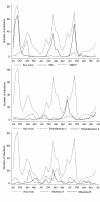RNA viruses in community-acquired childhood pneumonia in semi-urban Nepal; a cross-sectional study
- PMID: 19635124
- PMCID: PMC2727531
- DOI: 10.1186/1741-7015-7-35
RNA viruses in community-acquired childhood pneumonia in semi-urban Nepal; a cross-sectional study
Abstract
Background: Pneumonia is among the main causes of illness and death in children <5 years of age. There is a need to better describe the epidemiology of viral community-acquired pneumonia (CAP) in developing countries.
Methods: From July 2004 to June 2007, we examined nasopharyngeal aspirates (NPA) from 2,230 cases of pneumonia (World Health Organization criteria) in children 2 to 35 months old recruited in a randomized trial of zinc supplementation at a field clinic in Bhaktapur, Nepal. The specimens were examined for respiratory syncytial virus (RSV), influenza virus type A (InfA) and B (InfB), parainfluenza virus types 1, 2 and 3 (PIV1, PIV2, and PIV3), and human metapneumovirus (hMPV) using a multiplex reverse transcriptase polymerase chain reaction (PCR) assay.
Results: We identified 919 virus isolates in 887 (40.0%) of the 2,219 NPA specimens with a valid PCR result, of which 334 (15.1%) yielded RSV, 164 (7.4%) InfA, 129 (5.8%) PIV3, 98 (4.4%) PIV1, 93 (4.2%) hMPV, 84 (3.8%) InfB, and 17 (0.8%) PIV2. CAP occurred in an epidemic pattern with substantial temporal variation during the three years of study. The largest peaks of pneumonia occurrence coincided with peaks of RSV infection, which occurred in epidemics during the rainy season and in winter. The monthly number of RSV infections was positively correlated with relative humidity (rs = 0.40, P = 0.01), but not with temperature or rainfall. An hMPV epidemic occurred during one of the three winter seasons and the monthly number of hMPV cases was also associated with relative humidity (rs = 0.55, P = 0.0005).
Conclusion: Respiratory RNA viruses were detected from NPA in 40% of CAP cases in our study. The most commonly isolated viruses were RSV, InfA, and PIV3. RSV infections contributed substantially to the observed CAP epidemics. The occurrence of viral CAP in this community seemed to reflect more or less overlapping micro-epidemics with several respiratory viruses, highlighting the challenges of developing and implementing effective public health control measures.
Figures




References
-
- Berman S. Epidemiology of acute respiratory infections in children of developing countries. Rev Infect Dis. 1991. pp. S454–462. - PubMed
-
- Iwane MK, Edwards KM, Szilagyi PG, Walker FJ, Griffin MR, Weinberg GA, Coulen C, Poehling KA, Shone LP, Balter S, Hall CB, Erdman DD, Wooten K, Schwartz B. Population-based surveillance for hospitalizations associated with respiratory syncytial virus, influenza virus, and parainfluenza viruses among young children. Pediatrics. 2004;113:1758–1764. doi: 10.1542/peds.113.6.1758. - DOI - PubMed
-
- Henrickson KJ, Hoover S, Kehl KS, Hua W. National disease burden of respiratory viruses detected in children by polymerase chain reaction. Pediatr Infect Dis J. 2004. pp. S11–18. - PubMed
Publication types
MeSH terms
LinkOut - more resources
Full Text Sources
Miscellaneous

